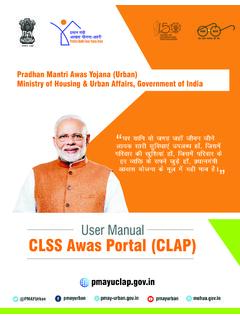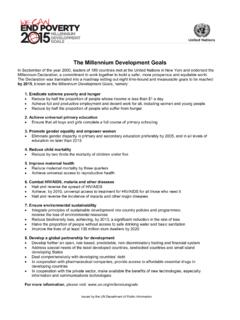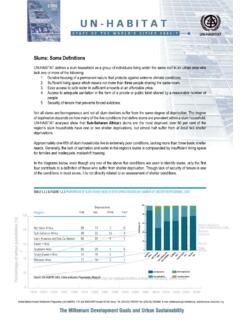Transcription of What Is Performance-Based Contracting?
1 SECTION 2. what Is Performance-Based contracting ? SECTION 2. Introduction This section provides some background about Performance-Based contracting and sets contracting within the context of other ways of organizing health services. It answers the following questions: what is contracting ? contracting is a mechanism for a financing entity to procure a defined set of health services from a nonstate provider (NSP). The definition of services includes what services, where, to which group of beneficiaries, for how long, and so on. what is Performance-Based contracting ? It is a type of contracting with (1) a clear set of objectives and indicators, (2) systematic efforts to collect data on the progress of the selected indicators, and (3) consequences, either rewards or sanctions for the contractor, that are based on performance . what kinds of services can be contracted?
2 Many different types of health services have been successfully contracted, including primary health care, HIV prevention services, and hospital management. How is contracting different from other approaches to organizing health services? contracting implies that it is the 9. 10 Performance-Based contracting for Health Services in Developing Countries purchaser (rather than the NSP) that defines what services will be provided, where, and how they will be evaluated while leaving to NSPs how resources will be managed. what approaches to contracting work best in common situations? It is difficult to be prescriptive, but some situations are more conducive to specific forms of contracting than others. How is contracting related to paying for performance (P4P)? Performance-Based contracting is a form of paying for performance and can be used as a way of implementing P4P.
3 SECTION 2. what Is contracting ? contracting is a mechanism for a financing entity (such as a govern- ment ministry, insurance entity, or development partner) to acquire a specified set of services, with specified objectives, of a defined quantity, quality, and equity, in a particular location, at an agreed-on price, for a specified period, from a particular NSP (such as an NGO, private sec- tor firm, or private practitioner). Like all contracts, contracts for health services are voluntary, meaning both parties enter them freely. A few other terms related to contracting should be defined: Nonstate providers. Nonstate providers of services include any nongovernmental entity such as NGOs, faith- based organizations (FBOs), community- based organizations (CBOs), or private for- profit entities or individuals. Contractor. The contractor is the NSP implementing and managing the services defined in the contract.
4 Another useful term for contractor is partner, although the term contractor is used throughout this toolkit for the sake of simplicity. Purchaser. The purchaser is the entity that awards the contract, provides the financial and other resources for the services, and has the fiduciary responsibility for ensuring that the terms of the contract are met. Purchasers of health services are typically government agencies, parastatal organizations, insurance entities, or development partners. what Is Performance-Based contracting ? 11. Public-private partnerships. contracting is one form of public- private partnership. A partnership sometimes implies that both parties bring financial or other resources into the relationship, but this is not always the case. what Is Performance-Based contracting ? Performance-Based contracting is a form of contracting that explicitly includes three characteristics: SECTION 2.
5 Clear definition of a series of objectives and indicators by which to measure contractor performance Collection of data on the performance indicators to assess the extent to which the contractors are successfully implementing the defined services performance leading to consequences for the contractor, such as provision of rewards or imposition of sanctions. Rewards can include continuation of the contract in situations in which there is a credible threat of termination, provision of performance bonuses, or public recognition. Sanctions can include termination of the contract, financial penalties, public criticism, and debarment from receiving future contracts. what Kinds of Health Services Can Be Contracted? A large variety of health services can be, and have been, contracted. These include the following: Providing primary health care services in rural or urban areas Offering HIV prevention services among high-risk groups Providing HIV/AIDS treatment services to people living with HIV.
6 Establishing a health insurance system Setting up and operating a voucher project 12 Performance-Based contracting for Health Services in Developing Countries Acting as an intermediary in providing P4P to public health care providers Offering behavior change communication activities and information, education, and communication Providing maintenance and cleaning services in a hospital Providing social marketing of health products, such as contraceptives Working as an umbrella agency that oversees the work of many smaller NGOs and CBOs involved in delivering primary health SECTION 2. care, nutrition services, or HIV services Operating an ambulance system Acting as an intermediary with many for-profit providers, for example, in strengthening the management of tuberculosis patients Managing a hospital Operating diagnostic facilities within public health care facilities Providing ancillary services such as equipment maintenance, cleaning, waste management, food preparation, and security.
7 Sample terms of reference for some of these services are provided in appendix E; others are available at contracting . How Is contracting Different from Other Approaches to Organizing Health Services? Typology of Service Delivery. A number of different approaches exist for organizing health service delivery, so clarifying definitions will facilitate meaningful dialogue. Although this is a bit of a simpli- fication, there are five important functions related to service deliv- ery: (1) designing the services, that is, what services will be delivered, where, and with which indicators of success; (2) selecting the service provider; (3) actually managing the services; (4) establishing and con- trolling the production infrastructure, which includes personnel, what Is Performance-Based contracting ? 13. equipment, drugs, clinics, and other facilities; and (5) financing the system (see table ).
8 As an example, under a management contract (arrangement 3 in table ), a government will contract with an NSP. or an individual to manage existing government services in a speci- fied area. Under a service delivery contract (arrangement 4 in table ), the government decides which services the contractor will pro- vide and where, while the contractor will both manage and supply the production infrastructure. The arrangements described in table are not exhaustive, and hybrids clearly exist. For example, the line between a management contract and a service delivery contract blurs when the contractor uses government health workers but pays them SECTION 2. significantly more than their civil service salaries. Intergovernment Contracts. There has been some experience with national governments signing agreements with local governments (arrangement 2 in table ) that pertain to achieving certain goals.
9 Although potentially interesting, this arrangement rarely involves a true contract that the parties enter into voluntarily and in which the contractor can be fired for nonperformance (although other rewards and sanctions may be available). Another issue with such contracts is that denying resources to poorly performing areas can be politically or ethically challenging. The Difference between Grants and Contracts. Grants by gov- ernment or donors to NSPs, often NGOs (see arrangement 5 in table ), are quite common, particularly in HIV/AIDS prevention and treatment. These grants are usually given to organizations that sub- mit a proposal to a funding agency. The most important difference between grants and contracts is who defines the services to be deliv- ered. For grants, it is generally the NSP that decides what kinds of services will be delivered, where they will be delivered, and how they will be evaluated.
10 As the funding agency defines more and more of the details of the services to be provided, the distinction between grants and contracts blurs. Grants can be very useful and have worked well in many situations. They are particularly helpful in beginning new types of services or providing an opportunity for creative innovations to address health problems. The downside to grants is that they can lead to an irrational distribution of services with gaps in some areas and duplication in others. For example, in Ghana epidemiologists believed that about 70 percent of HIV transmission involved female sex workers (FSWs). However, when a grant mechanism was introduced to control SECTION 2. 14. Table Typology of Service Delivery Arrangements Services Arrangement Service design Provider selection management Infrastructure setup Financing Example 1. Government Government Government Government Government Government Government sets up public services primary health care centers 2.

















